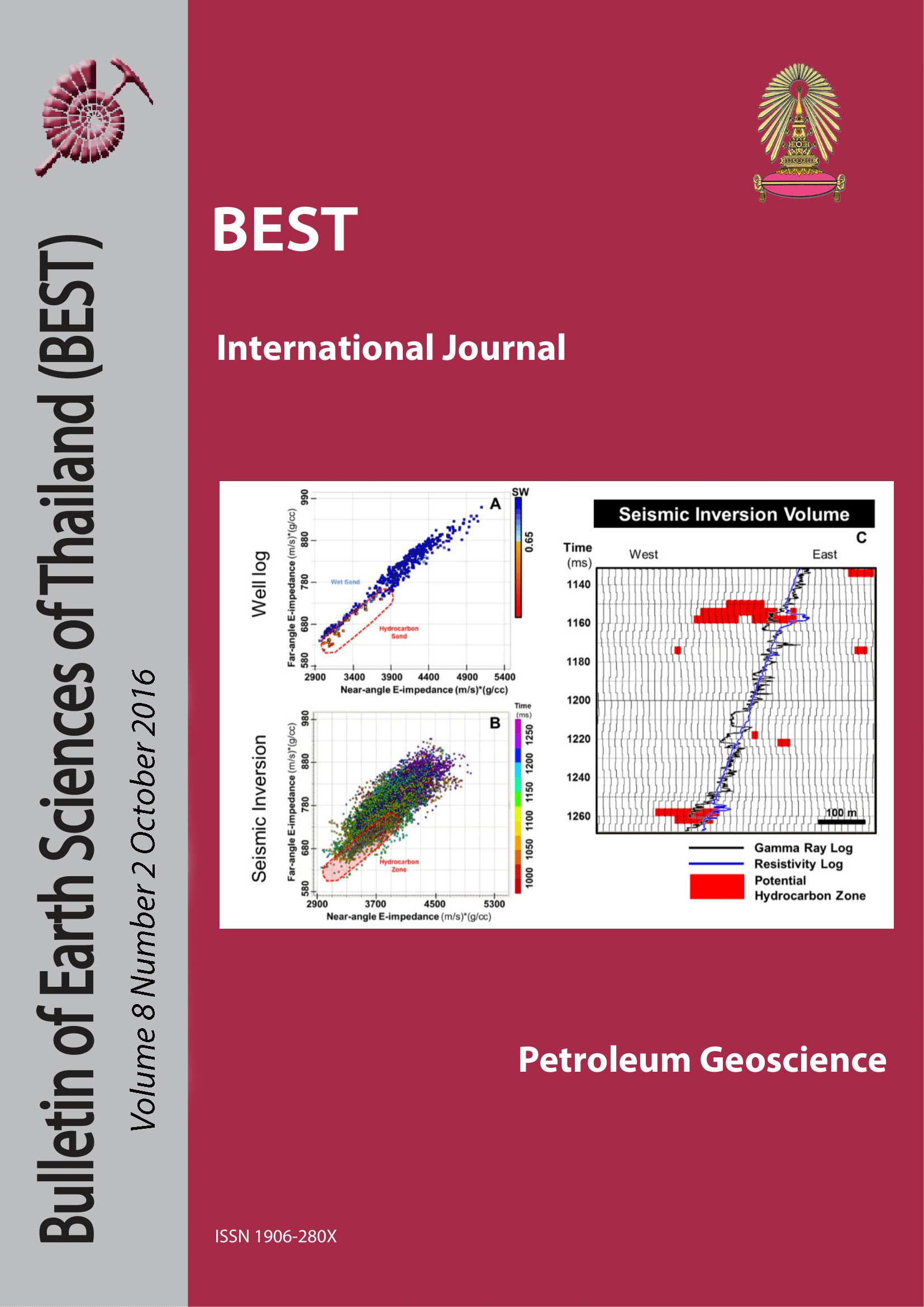APPLICATION OF POST-STACK SEISMIC INVERSION AND ITS LIMITATIONS FOR MAPPING OF FLUVIAL SYSTEMS IN WESTERN PATTANI BASIN, GULF OF THAILAND
Main Article Content
Abstract
Reservoir rocks in the Pattani Basin are fluvial sandstones which are highly compartmentalized due to their complex depositional and structural evolution. Imaging of these reservoirs is not always possible using conventional seismic data. This study presents rock physics analysis for the feasibility of post-stack seismic inversion within different sequences of the western part of the Pattani Basin. The post-stack seismic inversion was executed for the mapping of fluvial reservoir sands. Rock-physics results reveal that P-impedance values of sands are less than shales in the late Middle Miocene and Early Miocene depositional sequences. Some of the thin shales within the early Middle Miocene have very low P-impedance that is equivalent to sands. These are interpreted as marginal marine coaly mudstones. Blind tests demonstrated that sands could be differentiated from shales in Early Miocene and partially differentiated in the late Middle Miocene sequences. Geomorphological analysis of horizon slices extracted from Pimpedance volumes showed that sands associated with the channels are narrow and of high sinuosity in the Early Miocene and early Middle Miocene, whereas wide channels were observed in the late Middle Miocene. Marine influence has been inferred from the presence of marginal marine coaly mudstone. The marine incursions are more dominant in early Middle Miocene sequence and initiated in Early Miocene from the southeastern part of the area.
Article Details

This work is licensed under a Creative Commons Attribution-NonCommercial-NoDerivatives 4.0 International License.
Copyright © 2008 Department of Geology, Faculty of Science, Chulalongkorn University. Parts of an article can be photocopied or reproduced without prior written permission from the author(s), but due acknowledgments should be stated or cited accordingly.
References
Application of Spectral Decomposition and Seismic Attributes to Understand the Structure and Distribution of Sand Reservoirs within Tertiary Rift Basins of Gulf of Thailand: The Leading Edge, v.31, no.6, p.630-634.
Ahmad, M.N., and P. Rowell, 2013, Mapping of fluvial sand sytems using rock physics analysis and simultaneous inversion for density: case study from the Gulf of Thailand: First break, v.31, p.49-54.
Champasa, P.,2015, Different Types of Organic-Rich Geological Markers in Surat, Central North of Pattani Basin, Gulf of Thailand, Master’s thesis, Chulalongkorn University, Bangkok, Thailand, 42 p.
Jardine, E., 1997, Dual petroleum systems governing the prolific Pattani basin, offshore Thailand: Indonesian Petroleum Association Proceedings of the Petroleum Systems of SE Asia and Australia Conference, p. 351-355.
Kamvan, J.,2013, The Different Types of Organic-Rich Geological Markers in the Sub-Surface in the North Pailin Field, Pattani Basin, Gulf of Thailand, Master’s thesis, Chulalongkorn University, Bangkok, Thailand, 52p.
Li, Y., Z.Q. Guo, C. Liu, X. Y. Li, and G. Wang, 2015, A rock physics model for the characterization of organic-rich shale from elastic properties: Petroleum Science, v.12, no. 2, p.264-272
Morley, C.K., P. Charusiri, and I.M. Watkinson, 2011, Structural geology of Thailand during the Cenozoic, in Ridd, M.F., A.J.Barber, and M.J.Crow, eds., The Geology of Thailand: London, Geological Society, p.273-334
Narapan, J.,2015, Different Types of Organic-Rich Geological Markers in South Pailin Field, Pattani Basin, Gulf of Thailand, Master’s thesis, Chulalongkorn University, Bangkok, Thailand, 51 p.


